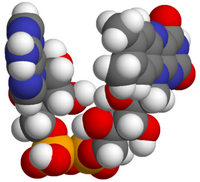
Photo from wikipedia
BACKGROUND Flavin adenine dinucleotide (FAD) is a redox-active coenzyme that regulates several important enzymatic reactions during metabolism. FAD is used in the medicinal and food industries and FAD supplements have… Click to show full abstract
BACKGROUND Flavin adenine dinucleotide (FAD) is a redox-active coenzyme that regulates several important enzymatic reactions during metabolism. FAD is used in the medicinal and food industries and FAD supplements have been used to treat some inheritable diseases. FAD can be biosynthesized from flavin mononucleotide (FMN) and adenosine triphosphate (ATP), catalyzed by FAD synthetase (FADS). OBJECTIVE The aim of this study was to heterologously express the gene encoding FADS from the flavinogenic yeast Candida famata (FADSCf) for biosynthesis of FAD. METHODS The sequence encoding FADSCf was retrieved and heterologously expressed in Escherichia coli. The structure and enzymatic properties of recombinant FADSCf were characterized. RESULTS FADSCf (279 amino acids) was successfully expressed in E. coli BL21 (DE3), with a theoretical molecular weight of 32299.79 Da and an isoelectric point of 6.09. Secondary structural analysis showed that the number of α-helices was 2-fold higher than the number of β-sheets, indicating that the protein was highly hydrophilic. Under fixed ATP concentration, FADSCf had a Km of 0.04737±0.03158 mM and a Vmax of 3.271±0.79 μM/min/mg. Under fixed FMN concentration, FADSCf had a Km of 0.1214±0.07464 mM and a Vmax of 2.6695±0.3715 μM/min/mg. Enzymatic reactions in vitro showed that expressed FADSCf could form 80 mM of FAD per mg of enzyme after 21 hours under the following conditions: 0.5 mM FMN, 5 mM ATP and 10 mM Mg2+ . CONCLUSION Under optimized conditions (0.5 mM FMN, 5 mM ATP and 10 mM Mg2+), the production of FAD reached 80 mM per mg of FADSCf after a 21-hour reaction. Our results indicate that purified recombinant FADSCf can be used for the biosynthesis of FAD.
Journal Title: Protein and peptide letters
Year Published: 2020
Link to full text (if available)
Share on Social Media: Sign Up to like & get
recommendations!